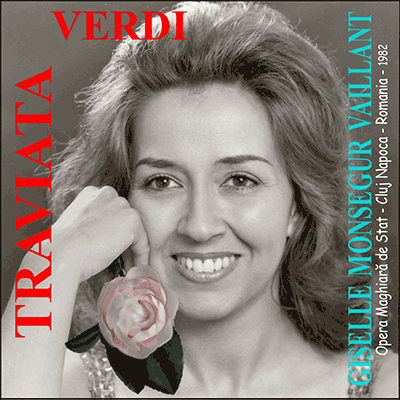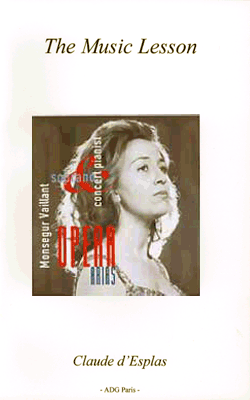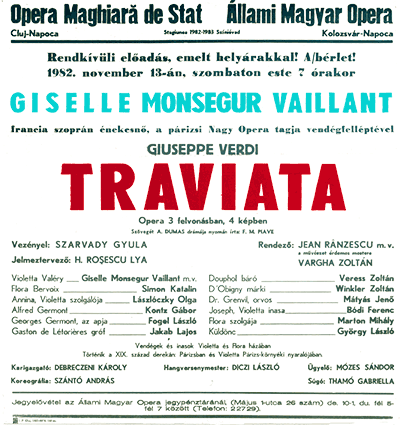|
|

‘Amami Alfredo, amami quant’io t’amo’: never before did such a cry of love stir up the bowels of the spectators in an opera house. Violetta runs towards the garden in the immense silence of an applause which will not come. The eyes of the bejewelled women are shining strangely, the men are holding their breath, the conductor’s bâton (He sang in Vienna!) stays in suspense, Alfredo immobilizes before this ‘silver’ voice, as defined by Jean-Jacques Rousseau, with harmonics that blend sonorities of pure metal and a timbre of the finest crystal: ‘Addio!’... 28 may 1955, Teatro alla Scala: the Greek tragedian Maria Callas leaves the scene on the same Addio, projected by this copper voice with streaks of impure metal and of anguish from a recent past, greeted by a hurricane of enthusiasm (paid applauders included), as the Bellincioni alone was capable of unleashing — according to Tomasi di Lampedusa, author of the Gattopardo (The Cheetah) — whose ‘Amami, Alfredo’ was not to be missed. The formidable voice of the barytone Germont fills the hall with its sheets of bronze (‘Di Provenza il mar, il suol’), timbre radiating over the Crau and the Camargue of Mirèio who ‘holds to the golden sun the brown arch of her eyebrows’, over the matadors and over the gipsy people come from afar and whose ancestors left Walachia at the call of the passing wind, going from tchardas (guest-houses) to tchardas, the harmony of the herds and the bells of the carroutzas in tune, selling their wives or their daughters when they are too good or too foolish, not without stealing in passing and thanks to their bows, divided like for a grandiose Prelude and on mazurka cadences, the heart of Franz Liszt or that of young country girls in low-cut blouses who enter the round (hora) with this rhythmic step that will later be the glory of the beautiful gymnasts; and this perhaps in order to carry out — just reversal of events (ô Taven!) — the penitence of the God whose Vicar sentenced them to not ‘sleeping in a bed for seven years’ because they read ‘in the hands of the people’ (‘D’ognuno sulla mano, leggiamo l’avvenire’), before joining, via Vincent’s Valabregue, in the church of Saintes Maries de la Mer, their patroness Sarah, the servant of the Three Marie who knew the Lord Jesus. For there is, down there, between Rhine and Danube, a people related to Ours and whose history flatters itself to have distinguished Murat, small peasant of the Lot, future marshall and king of Naples, a people who lives in a country where winter is very long, spring very short, summer torrid, ripening the vines and the corn of the endless plain that undulates as far as Baltsi and where the French language is like a second national language, a people who, in the person of the greatest of their poets, is thus greeted by Frederic Mistral in his poem: A la Roumanìo (1890): ‘E t’apellant germano Pieces of glowing ash are smashed on the windows of the compartment, while in the never-ending bend of the railway line in the area of Turda the black locomotive can be seen piercing the night of Trajan Dacia under a moon looking like a frosty orange This morning Violetta left Bucarest and the banks of the Dombovitsa (‘who has drunk water from the Dombovitsa, will come back to drink again’, says the proverb) on the edge of the rough and fairy-like crossing of the Carpathian Mountains with jagged peaks like lace-work which one might think to be cut out, in the area of Sinaïa, by some poetess-Queen, sometimes flanked by castles safely erected to cut off from the world this singer whose wrist was adorned with a bracelet of diamonds the size of hazelnuts, presented by Tsar Alexander II, singer and far-away Princess for whom Jules Verne, general secretary of the Grande Boutique, searched in vain. These Carpathian Mountains tinged with blue under the November sun which vocalizes on the summits of the Bucegi, like those of Linda di Chamonix, and whose peaks are more brilliant than the ridges of the Bigorre where Marguerite Gautier strengthened the convalescence of her heart and the valleys, more tender than those of Cauterets where Giuseppe Verdi treated his throat problems and, on occasion, invited Escudier whom he had instructed that ‘one must not cough in the last act of La Traviata’; while in the cushioned ambiance of the restaurant-car piquant sauces and crêpes Suzette called for some generous wine unknown to the café ‘Point du Jour’ at Bougival, by the tranquil waves of the deep Seine between the plaine des Gabillons and the island of Croissy (‘Ah! Ah! scopriva Flora, il mio ritiro’) where one hears the murmur of the willowtrees, as the cobzar sings: ‘How happy the Italians are’, exclaimed Chabrier (this is reported by Saint-Saëns) while sitting down at the piano to sing the phrase ‘Parigi, o cara’ with as much passion as a Toscanini reacting to the acidy voice of his aseptic Violetta in the NewYork recordings of 1946 (‘Santa Madonna, orribile!...’) It is now far, the Parigi of the boulevard de la Madeleine, of the rue d’Antin, of the rue de Provence, the Paris of the Palais Garnier (‘Miei cari, sedete, è al convito que s’apre ogni cor’) behind which presses the crowd of buyers, on the doorstep of Christmas, close to the Mogador theatre where the very young Violetta made her debut in the Veuve Joyeuse (‘Non gradireste ora la danza’) before confronting, in this church, a few miles from Nonant-le-Pin which saw Alphonsine Plessis entering the Demi-Monde, and younger than Clara Wieck, the painful scales of Frauenliebe und Leben, those of Liebestraum by Franz Liszt who knows how to speak to women, or L’Invitation à la Valse, by Weber, as far as the famous part in major that never stopped her: D,E,D,C,D,F,E,D... or — with this child voice rising up to... Him — the Prière by Gabriel Fauré, such as sung later in theAmerican Cathedral of Paris. Far is the Paris of the Variety Theatre that was to receive in an astonishing Opera Non Stop the French voices of the century (‘Tra voi, tra voi, sapro dividere, il tempo mi giocondo...’), at a short distance from the Gaumont Palace and from the Pont Caulaincourt which unites the souls of Dumas and of his heroine whose escape can only end up on the Boulevard de Clichy in the middle of this permanent and nocturnal Carnival which, from Moulin Rouge to Moulin de la Galette, dispels, with its artificial flowers, the ennui of the ‘wandering Marguerites’ (‘che far degg’io!.. Gioire!...’); the Parigi of Madame Barjon’s camelias, the marguerites of the garden of Croissy, of the geranium (‘Prendete questo fiore’) which Dumas son offered to Mélanie W., the true heroine of Antony, in order to cure her from her sulking bouts and with whom he once met at Père-Lachaise cemetery; the Parigi of the roses on the balcony of Maria Callas who drew the curtains of her flat at Trocadéro before the ultimate finale of Amore e Morte (‘Ah! Gran Dio! Morir si giovine...’). This is now the station shrouded in mist and steam, the deep look in the eyes of the travellers from the heart of the steppes, the wide avenues sparsely illuminated, swept by a glacial wind, the façade of the Romanian Opera, blue and red coloured posters on boards and kiosks, the rehearsals, the musicians standing to see just who this ‘voice’ is, the Press, the observers huddled in the hall’s semi-darkness, the costumes workroom where a hive of capable little hands is buzzing, making to measure Violetta’s sumptuous dress as Catherine Lebay would have done, the humble Brussels seamstress led astray by the creator of Monte-Cristo, in the woods of Meudon, before becoming mother of the author of La Dame aux camélias (‘Se una pudica vergine, Degli anni suoi sul fiore’), the crowd who waited, ‘coughing’, for the doors to be opened, after besieging, for three whole weeks, the Director’s telephone in the hope of a returned ticket, and who now rustles with silk and who sparkles with precious stones in the theatre’s spacious hemisphere from where Alexander Korda set out to conquer the all-Hollywood and whose walls exhibit the portraits of the stars who have rendered illustrious Magyar Opera since 1948. In her dressing room, Violetta dressed in Verdi music only, or very nearly, puts on her sumptuous dress of black taffeta, with red scallops, in the midst of flashing cameras, questioning journalists (‘Accompaniamentul orchestrei este foarte important pentru mine... Violeta e un rol dificil...’) before the last vocalization (will the D-flat be willing to join the Feast?) up there in the lonely and icy Director-writer’s office. The corridor which goes as far as the stage, the crowd who grumbles like a sea in front of the curtain, and this is already the end of the Prelude, which accelerates Violetta’s heartbeat, as it caused palpitation to Ponselle, Muzio, Sills, Olivero or others like Sembrich and Caniglia, not to mention la Spezia, disdained by Paris and of whom Verdi expected that she would reveal certain passages of which one does not think and that ‘would be new for all’. In these moments of the finale ‘Ah, fors’e lui’, Violetta feels like a passing of the shadow of the great singers, who wore the title-dress before this same audience: Zeani, Cotrubas, Varady and the unforgettable Anna Rosza-Vassilyu, they who were or are the soul of the beautiful evenings at the Met or at the Scala, with this soprano voice, slightly harsh, which scrapes the timbre as it is coming out; the pompompom of Giulini’s Rachel finds its answer in the racinian shivers of a Sarah Bernhardt, drunk with these farewell vocalizations to bel canto (‘come è scritto, come scritto’, since Verdi, at least Proust says so, is supposed to have given to La Dame aux Camélias the style she was lacking in Dumas’ work) in the ‘Sempre libera’, dear to the free Strepponi, a farewell that still today causes like a fleeting light of anguish in the fixed pupils of the great early interpreters of the Casa Verdi or elsewhere (neither Freni of the Scala, nor Sutherland of Genova — or was it in Parma? — will issue a dementi!). The matador Germont, madly acclaimed by the delirious crowd, will leave the arena of Provenza; but, since the rehearsal of the previous night, this shortened version of Titan climbing the Olympus of song, bears the marks of a strange ‘dite alla giovine’, he who, indeed, would have made an understudy of a Bastianini and relegated the other historico-lyrical tubers to the rank of opera forestage prompters; this ‘dite alla giovine’ which the composer transposed in E flat major, completely unbeknown, it seems, to the contemporary pseudo-critics who obstinately insist on going into ecstasy over the andante of the 28th May 1955 at the Teatro alla Scala, this ‘dite alla giovine’, supreme example of auditive shortsightedness (may we be forgiven by Mademoiselle Kalogeropoulos whose ‘counter-F’ in Norma (!) were admired by this grand couturier of Saint-Remy, himself an expert of alto parts! That being an argument for appointing him Head of the ‘Grande Boutique’ (Urous pichoun Bergié!...). Under the transparent négligé of act III, straight from the Boulevard des Capucines and from the Paris of the Bœuf Gras, if not of the ‘blague’ (humbug), the diaphanous tinges of the ‘Addio del Passato’ blend with the colour of ‘dor’ (grief and desire) of this act which fully satisfied Verdi through Nilsson alone, countess of Casa Miranda, because, with her blond voice of snow, she had dared interiorize the role: ‘E strano!’ (It is strange!)... The curtain has fallen, in an immense silence. Suddenly, as if directed by an invisible bâton, the audience rises and applauds: piano, allegro, forte, fortissimo, long, long, frantically, frantically, no end to it, desperate, no end to it, desperate... The conductor, tears on his face, his hand trembling, makes an effort to trace his signature into the Golden Book. In Violetta’s dressing room, the barytone, all pale, bows and says thank you; the tenor, shattered (‘Un di felice...’), wipes up the drops of sweat running down his bare body. Violetta, escorted by the delicate basket of precious flowers which Tutti e coro had deposited at her feet on the occasion of the finale of Act II, enters the dining-hall of the Grand Hotel, in the midst of the diners and the masks of Saturday evening; the orchestra attacks the Funiculi, funicula... as at the San Carlo, as at the Fenice. Violetta understands and does not hold back any more the tears which are inundating her heart. Claude d’Esplas (The Music Lesson) |
ADG-Paris © 2005-2024 - Sitemap






